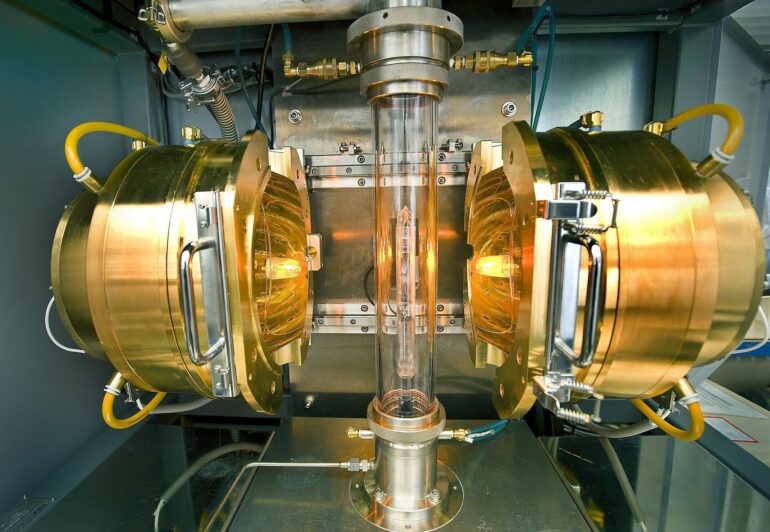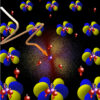Initially regarded as a scientific curiosity upon its discovery in 1911 by Heike Kamerlingh Onnes, superconductivity has provided physicists with numerous theoretical challenges and experimental surprises. From the development of Bardeen-Cooper-Schrieffer (BCS) theory at the University of Illinois Urbana-Champaign in 1957 to the discovery of high-temperature superconducting cuprate ceramics in 1987, superconductivity continues to command attention for its scientific importance as well as its potential applications.
Today, high-temperature superconductivity is one of the biggest unsolved problems in condensed matter physics. Researchers are continuing Illinois’ strong tradition of breakthrough discoveries in this field: Illinois physicists have recently uncovered a key connection between symmetry and Mott physics (the physics underlying high-temperature superconductors). These theoretical findings by principal investigator and Illinois Physics Professor Philip Phillips, Illinois Mathematics Research Professor Gabriele La Nave, and Illinois Physics postdoctoral researcher Edwin Huang, published March 21, 2022, in the journal Nature Physics, represent a big step toward understanding high-temperature superconductivity.
From Fermi liquids to broken symmetries
The cuprates, a class of high-temperature superconductors, hold the record for the highest superconducting transition temperature at ambient pressure—these are the so-called Mott insulators. In these materials, electrons are strongly interacting, unlike those in normal metals which move independently, as described by Fermi liquid theory. Previous works tackling Mott physics have dealt with strong interactions by focusing on analytically intractable models, such as the Hubbard model. These approaches must resort to numerical simulations because of the models’ inherent complexity. Now, Illinois researchers have found a simpler universal description that explains Mott physics in beautiful detail.
Phillips says, “Interactions make the problem of superconductivity quite intractable. What we found is a workaround. We found a simplifying symmetry that allows us to think about the interactions in a new way.”
A clue to this method was provided by Nobel laureates Philip Anderson and Duncan Haldane in 2001 when they discovered a symmetry by writing down a particle-hole transformation that preserves the Hamiltonian of a Fermi liquid.
Phillips explains, “Anderson and Haldane showed that the standard theory of metals—Fermi liquid theory—contains a hidden symmetry, one that is associated with interchanging particles and holes for just a single spin species.
“Mott insulators are often thought of as things that don’t break any symmetries. And because they don’t break any symmetries in this view, they’re difficult to characterize. What we found is that they do break a symmetry, namely, the hidden symmetry pointed out by Anderson and Haldane.”
This observation proves to be a crucial step. The key insight the researchers made in the current work is that upon breaking this symmetry—for example, by adding or removing particles or holes via doping—one “destroys” a Fermi liquid. Put another way, this observation implies that all models of Mott insulators must break this particle-hole symmetry.
Discovery of a fixed point
To solve superconductivity in normal metals, John Bardeen and his team considered a non-interacting electron system and developed a theory of superconductivity. For Phillips’ team, the goal was to perform an analogous construction by starting with a Mott insulator and developing a theory for high-temperature superconductivity.
Phillips explains, “To solve the high-temperature superconductivity problem, one must do exactly what Bardeen did for Fermi liquids—that is, normal metals. In other words, one must show that there exists a fixed point and that the only deformation that destroys it is superconductivity.”
Once the researchers recognized that breaking the hidden symmetry of the Fermi liquid leads to Mott insulation, they looked to existing analytically tractable models that break this symmetry and might lead to fixed points.
Phillips continues, “We then asked the question, ‘What is the simplest model that breaks this symmetry?’ The result is a surprise. It is a model proposed in 1992that, once again, no one took seriously: the Hatsugai-Kohmoto model.”
Until recently, the most popular way of tackling high-temperature superconductivity and Mott physics has been the Hubbard model. Unfortunately, rigorous results for this model are difficult—and sometimes impossible—to obtain. The Hubbard model is exactly solvable in only the one-dimensional case.
The Hatsugai-Kohmoto (HK) model, on the other hand, is appealing because of its simplicity. Phillips and his team previously provided an exact solution of the HK model in doped Mott insulators and showed that non-BCS superconductivity emerges.
In their latest publication, the researchers demonstrated that the HK model is the simplest model that breaks the particle-hole symmetry. To accomplish this task, the researchers tracked those symmetries that survived the Mott metal-to-insulator transition. They found that the HK model breaks precisely the same hidden symmetry outlined by Anderson and Haldane in Fermi liquids, showing that the HK model leads to a Mott insulator. In particular, they showed that the HK model introduces the correct—and only relevant—interaction required for Mott insulation. More importantly, they showed that the broken symmetry defines a new fixed point, a critical piece of the puzzle for solving the high-temperature superconductivity problem.
To illustrate the notion of a fixed point, one might take a Fermi liquid—a system of non-interacting particles—and introduce repulsive short-range interactions. However, one recovers a Fermi liquid upon introducing such interactions. That is, a Fermi liquid is fixed, or stable, in state space under any disturbances of this type.
One way to escape this Fermi liquid fixed point is to allow electrons to interact with each other pairwise—a process known as Cooper pairing—to achieve a superconducting state, just as Bardeen, Cooper, and Schrieffer described in 1957.
Another way to escape it is through symmetry breaking, which is exactly what Phillips’ team did.
The authors also demonstrated that the Hubbard model also breaks the particle-hole symmetry. Therefore, the HK model subsumes the Hubbard model and its implications, illustrating the HK model’s generality.
“Our results show that the HK model is a general way of understanding how one breaks a Fermi liquid with this hidden symmetry that was pointed out in 2001. We now understand that it’s a fixed point, putting us in a completely different regime of phase space from Fermi liquids,” Phillips notes.
This result is a breakthrough discovery, as it alleviates the overreliance that theorists have had on complicated models such as the Hubbard model. Moreover, this discovery is an outstanding example of universality, as the HK model is able to explain high-temperature superconductivity in broad generality. In more technical terms, this means that the Hubbard and HK models both lie in the same universality class—a principal goal of statistical mechanics and renormalization group theory.
At long last, an answer to the particle-hole asymmetry problem
The researchers’ work directly confronts a problem outlined by Anderson, who pointed out the condensed matter physics community’s failure to address particle-hole symmetry breaking in strongly correlated systems.
In his “Last Words on the Cuprates,” published in 2016, Anderson wrote, “I remain baffled by the almost universal refusal of theorists to confront this evident fact of hole-particle asymmetry head-on.”
Now, having shown that the HK model breaks this symmetry, which leads to Mott physics, the basis of high-temperature superconductivity, Phillips and his team are optimistic that their work will serve as a controlled platform for delineating how superconductivity emerges from a doped Mott insulator. They hope to use their model to close the gap between superconductivity from the HK and Hubbard models, thereby yielding a solution to the high-temperature superconductivity problem.
Commenting on why it has taken condensed matter theorists so long to catch on to the symmetry-fixed-point connection, Phillips speculates, “Physicists thought that the only way to get Mott physics was to solve the Hubbard model, but you don’t need a model as complicated as that one. When the HK model was proposed, many viewed it as a curiosity and ignored it. They knew neither that it broke a symmetry nor that it created a fixed point. They didn’t know that this model quite generally offers a gateway to the violation of Fermi liquid theory. No one followed up on this symmetry until we did.
“That realization was the hurdle holding everyone back. If they had realized this key observation, people would have solved the HK model long ago and seen that there are two classes of superconductors: those that lie in the BCS category, and those that lie in the high-temperature superconductor category. And that’s what we did.”
More information:
Edwin W. Huang et al, Discrete symmetry breaking defines the Mott quartic fixed point, Nature Physics (2022). DOI: 10.1038/s41567-022-01529-8
Provided by
University of Illinois at Urbana-Champaign
Citation:
Physicists elucidate connection between symmetry and Mott physics (2022, March 22)



